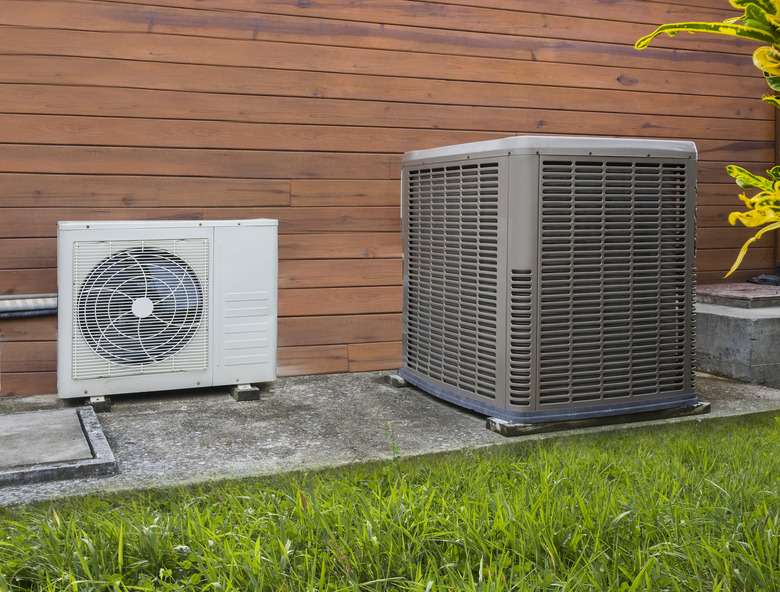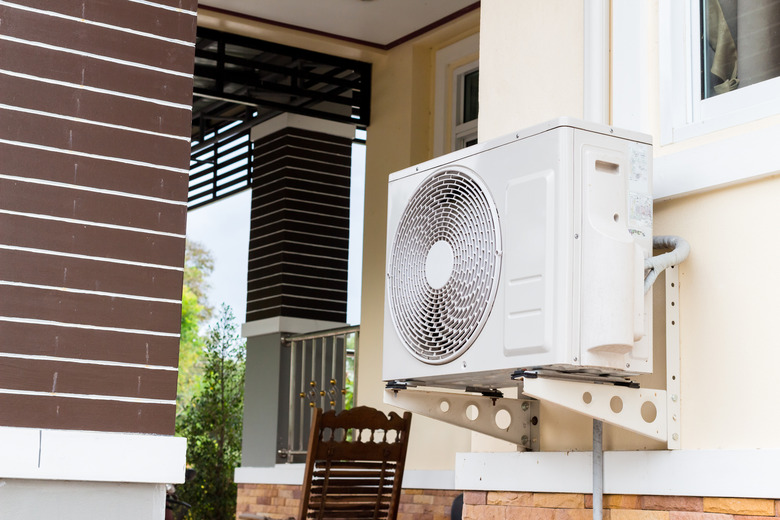How To Maintain Your Heat Pump: A DIY Guide
We may receive a commission on purchases made from links.
Homeowners can't do all of their own heat pump maintenance for the same reason they can't fix their own refrigerators — but the maintenance they can do is important, and it's a breeze. The main working part of a heat pump is a refrigeration unit consisting of tubing coils and a condenser, and because the refrigerant circulating through the coils is pressurized, servicing it without knowing what you're doing would be dangerous, and it's illegal. Release of refrigerant into the atmosphere is an environmental issue, and any HVAC technician that services refrigeration units must be appropriately certified. That's why it's important to schedule a yearly tune-up by an HVAC professional to keep your heat pump running efficiently.
A heat pump relies on more than its refrigeration system to operate smoothly, and regular DIY maintenance can make a 10 to 25 percent difference in efficiency and energy consumption, according to Energy.gov. Like a furnace or air conditioning unit, a heat pump needs good airflow, or it has to work harder to do its job, and it will consume more energy and wear out more quickly. It also has moving parts that need cleaning and lubrication, and while a service pro usually takes care of this as part of a tune-up, there's no reason for homeowners not to do it if too much time elapses between service calls.
How the Indoor and Outdoor Heat Pump Units Work
How the Indoor and Outdoor Heat Pump Units Work
A central heat pump system is a split system with two units: one indoors and one outdoors. Most of the action happens in the outdoor unit, where the compressor, compressor fan and heat exchange coils are located. They are all contained within a metal housing with louvers or grilles that allow air to circulate freely, and there is at least one air filter in the housing that needs to be changed or cleaned regularly.
The indoor part of the heat pump system is located inside an air handler, which is a large metal box that resembles a furnace. There may even be a furnace inside or next to the air handler if the heat pump is used for auxiliary heat. The indoor coils are located in the plenum at the top of the air handler where the ductwork is attached, and it's positioned so that the blower, which is typically at the bottom of the air handler, can circulate the heat produced by the coils throughout the HVAC system. The indoor unit also has an air filter that needs attention.
Heat Pump Maintenance Tips
Heat Pump Maintenance Tips
The bulk of DIY heat pump maintenance is focused on the outdoor unit. When the unit switches over to air conditioning mode during cooling season, the indoor and outdoor coils change functions, and the outdoor coil radiates heat. When the unit is in heating mode, however, the outdoor coil serves as the evaporator coil, and it can get cold to the point where it ices over.
Like an air conditioner coil, the outdoor coil draws moisture out of the air as well as heat. An air conditioner has a drain line to collect this condensate, but there usually isn't one in the outdoor unit of a heat pump because the water would just freeze and cause all kinds of problems, so the water falls to the ground and drains away. The heat pump periodically goes into a defrost cycle by switching from heating to cooling mode to make the outdoor coil hot and melt any ice that has collected, and for this short period (about 15 minutes), the unit may blow cold air into the house. This is normal, but if it happens too often, there's too much ice buildup, and you may have to de-ice the coils.
It's important to prevent airflow restrictions in the outdoor unit. Besides contributing to the icing over of the coil and making the compressor work harder, poor airflow limits the amount of heat the outdoor coil can exchange. That ultimately means less heat is available to circulate through the system. You may try to rectify this by changing the settings on your programmable thermostat, but you'll simply be making the compressor work even harder.
Things Needed
How to Maintain Your Heat Pump
1. Keep the Air Circulating
Check your outdoor unit for obstructions frequently and remove them. If you've just had a big snowstorm, turn off the thermostat or set it to emergency heat, go outside with a broom or shovel and clear all the snow and ice off the housing. Use a garden hose to melt the ice if necessary. You can even use warm water but don't use hot water. Remove foliage from around the base of the unit for a distance of at least 18 inches on all sides.
Clean or change the air filter on both the indoor and outdoor unit at least once a month. If you need to replace the filter, be sure the new filter is the same size and install it with the arrows pointing in the direction of the airflow.
2. Keep Your Outdoor Unit Dry
If you see water dripping on the outdoor unit, find the source and look for a way to redirect the water away from it. Make sure there's 4 to 8 inches of clearance underneath the unit to allow condensate from the coil and water that collects on the housing to drain away. If the unit doesn't have enough clearance, call an HVAC professional to raise it.
3. Clean the Coils and Fan Blades
Turn off the breaker controlling the heat pump and clean the outdoor coil periodically with a coil brush or with water and a degreaser. The coil has to be clean for optimum energy efficiency. While you're at it, it doesn't hurt to clean the fan blades as well since any dirt on them is likely to end up on the coil. This is also a good time to check the indoor coil and the blower blades and clean them if necessary.
4. Check the Electrical Connections
Inspect the electrical connections visually for signs of fraying, corrosion or loose wires. If you see any problems, call for service.
5. Lubricate the Fans
The fan motor in both the indoor and outdoor units are sealed and don't need lubrication, but the fan blades themselves sometimes need a little help to keep them spinning smoothly. Use a few drops of penetrating oil or a few squirts of spray lubricant on the fan spindles whenever you hear squeaking noises.
De-icing the Outdoor Coil
De-icing the Outdoor Coil
A heat pump has either a timer or a temperature sensor that instructs the control panel to reverse modes and heat up the outdoor coil when the unit is running in heating mode. If this defrost cycle doesn't remove all the ice from the coil, the heat pump won't supply heat, and you may have to defrost it yourself. The safest way to do this is to switch the thermostat from heating to cooling mode and run the system until all the ice is gone. You might not want to do this on a cold day, however, so the alternative is to manually de-ice the coil.
The most important thing to remember is to never do this by chipping away the ice with a sharp object. The coil is fragile and easily damaged, and the refrigerant inside is pressurized, so you could be injured if you puncture the coil. The recommended way to de-ice the coil is to switch off the system breaker and spray the coil with a garden hose until all the ice is gone. You may also have some luck by running the system in fan-only mode until the ice is gone, but this only works on warm days without freezing temperatures.

